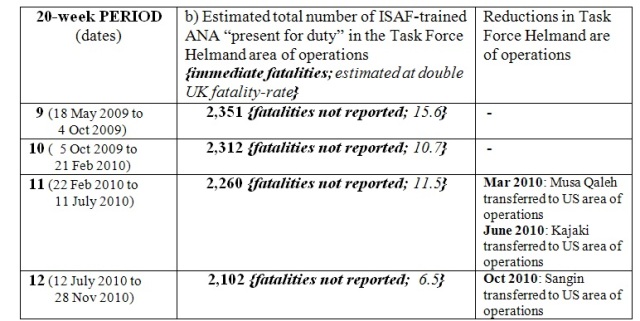Counted out, but not in
Since 1 May 2006, Bird and Fairweather have reported every 20 weeks on military fatalities in Afghanistan by nationality and cause.
But the nations whose military fatalities in Afghanistan we analyse have not included the Afghanis themselves. We thought this was remiss.
We sought the help of Patrick Mercer MP, himself a former soldier, to “out” key information on the numbers of Afghan National Army (ANA) personnel who had been trained by the International Security Assistance Force (ISAF) and were “present for duty” in the Task Force Helmand area of operations to work alongside UK forces.
The Table shows that, in recent 20-week periods, the estimated number of ISAF-trained ANA personnel who worked in partnership with UK forces ranged from 2,350 down to 2,100 (to nearest 50). We congratulate the Ministry of Defence for counting them. From 18 April 2011 until 2014/15, we should thus be able to monitor every 20 weeks any changes in the estimated numbers of ISAF-trained ANA personnel present for duty alongside UK forces.
The full answer to Patrick Mercer’s parliamentary question suggested that, across the whole of Helmand, the estimated numbers of ISAF-trained ANAs present for duty had actually increased. Regular assessment of the numbers of ISAF-trained Afghan soldiers present for duty, no matter which ISAF-contingent they work alongside in Helmand, is clearly important for monitoring of UK government’s objectives in Afghanistan.
But when Patrick Mercer asked about the number of fatalities among these Afghan soldiers for the same 20-week periods, no clear answer was forthcoming. Instead, rather obliquely, the Ministry of Defence replied: “This is a matter for the Government of Afghanistan. We do not hold information on the number of Afghan National Security Forces fatalities. “
It is, however, hardly credible that UK forces, who count out the Afghan soldiers fighting alongside them, do not also count them back in.
In particular, military commanders clearly care about fatalities from their force and, since Afghans fighting alongside UK forces would be evacuated to Camp Bastion for medical care if caught up in a major incident, commanders will at least know the number of immediate ANA fatalities – those who do not make it through the first 24 hours. Patrick will pursue further parliamentary questions to elicit this minimum tally of immediate fatalities.
Anticipating that he would not get all the information he sought at first pass, Patrick had also asked the Secretary of State for Defence: “if he will consider the merits of making regular reports to Parliament on the deployed number of (a) ISAF-trained Afghan National Army personnel, (b) ISAF-trained Afghan National Army personnel working in partnership with UK forces and (c) ISAF-in-training Afghan National Army personnel. “ We elicited (b) successfully; but not their fatalities.
Since between 2,100 and 2,350 ISAF-trained ANA personnel work alongside some 10,000 UK troops, and the entire ISAF-force is probably around 115,000, we may conjecture, in answer to a) above, that - other things being equal - some 24,000 to 27,000 ISAF-trained ANA personnel are currently deployed with the ISAF-force.
Our 24,000 to 27,000 is an approximate answer to the question that Paul Flynn MP tried unsuccessfully to get the Secretary of State for Defence to answer on 14 February 2011 when he asked about the number of inevitable desertions or dismissals among trainees.
Dr. Fox had given information only as follows: the number in the Afghan National Army as 152,000 and in the Afghan National Police as 117,000 against a target ‘to deliver 305,600 Afghan national security forces’ by October 2011.
For our sums to add up alongside Dr Fox’s, less than 20 per cent of the Afghan National Army may be ‘present for duty’ alongside an ISAF-force, the rest being otherwise present . . . or otherwise absent.
Even if the Afghan government does not sufficiently honour its personnel by counting immediate fatalities among them, UK commanders surely do. And, we suggest, should be seen to do so.
By setting a good example on whom to count, UK forces can give a lead within ISAF; and ISAF to the Afghan government in the public respect that it owes to service personnel who make the ultimate sacrifice for their country.
Literacy training, Dr Fox told the House, is now mandatory for all Afghan recruits. Perhaps numeracy training should be a priority for Afghan politicians so that, publicly, they keep count - as do other countries’ Ministers of Defence – of their military fatalities.
The numbers are not large. Even if the immediate fatality-rate was double that for the UK forces, the number of immediate ANA fatalities per 20-week period would be as shown in our table – surely not so many as to make the counting of them difficult?
A doubled fatality-rate might arise if ANA forces were less well led than their UK counterparts or through a greater tendency to negligent discharges of weapons. On the other hand, if inexperience meant that ISAF-trained ANA personnel were given follow-up tasks and were seldom ‘on point’, and so less likely to be first-in-contact, their fatality-rate could be lower than for UK military personnel. Either way, UK and Afghan publics alike should know it, and we should be analysing changes in the military fatality rate of ISAF-trained ANA personnel over time as we do for our own – both to honour their service, and learn from their sacrifice.




